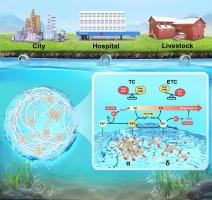Adsorption, epimerization and self-sustaining degradation: Muti-step detoxification of tetracycline via chitosan-supported mixed-phase FeOOH
IF 9
1区 工程技术
Q1 ENGINEERING, CHEMICAL
引用次数: 0
Abstract
Tetracycline (TC) antibiotics are common trace pollutants in aquatic environments, where they can accumulate and transform into epimers such as 4-epi-tetracycline (ETC), potentially increasing ecotoxicity. Therefore, developing effective and safe in-situ remediation technologies for the removal of TCs from natural waters is of critical importance. This study presents a fabrication method for magnetic chitosan-supported mixed-phase FeOOH particles (α/δ-FeOOH@CS), which are enriched with oxygen vacancies, for the adsorption and degradation of TCs. Significant epimerization of TC into ETC was observed during its removal. Batch experiments showed that 96% of TC and 97.6% of ETC could be removed by α/δ-FeOOH@CS. The main mechanism involves the chitosan-induced accumulation, Fe(III)-mediated complexation and oxidation, coupled with reactive oxygen species (ROS) generation initiated by Fe(II). These processes establish a self-sustaining Fe(III)/Fe(II) redox cycle for efficient in-situ remediation of TCs. The differing removal behaviors of TC and ETC are likely attributed to their distinct interactions with Fe(III), resulting from spatial changes in the C4 dimethylamino group. Additionally, algal toxicity tests conducted throughout the degradation process confirmed the near non-toxic nature of the removal steps, indicating that no significant new environmental toxic effects were introduced.


吸附、外显异构化和自持降解:壳聚糖负载的混合相FeOOH对四环素的多步解毒
四环素(TC)抗生素是水生环境中常见的痕量污染物,它们会在水生环境中积累并转化为表聚物,如 4-表四环素(ETC),从而可能增加生态毒性。因此,开发有效、安全的原位修复技术来去除自然水体中的三氯甲烷至关重要。本研究介绍了一种富含氧空位的磁性壳聚糖支撑混合相 FeOOH 粒子(α/δ-FeOOH@CS)的制造方法,用于吸附和降解 TCs。在去除三氯甲烷的过程中,观察到三氯甲烷与四氯化碳发生了显著的表聚反应。批量实验表明,α/δ-FeOOH@CS 可去除 96% 的 TC 和 97.6% 的 ETC。其主要机制包括壳聚糖诱导的积累、Fe(III)介导的络合和氧化,以及由Fe(II)引发的活性氧(ROS)生成。这些过程建立了一个自我维持的铁(III)/铁(II)氧化还原循环,从而实现了对三氯乙酸的高效原位修复。三氯乙酸和四氯化碳的不同去除行为可能是由于它们与铁(III)之间不同的相互作用造成的,这种相互作用是由 C4 二甲基氨基的空间变化引起的。此外,在整个降解过程中进行的藻类毒性测试证实,去除步骤近乎无毒,这表明没有引入新的重大环境毒性影响。
本文章由计算机程序翻译,如有差异,请以英文原文为准。
求助全文
约1分钟内获得全文
求助全文
来源期刊

Separation and Purification Technology
工程技术-工程:化工
CiteScore
14.00
自引率
12.80%
发文量
2347
审稿时长
43 days
期刊介绍:
Separation and Purification Technology is a premier journal committed to sharing innovative methods for separation and purification in chemical and environmental engineering, encompassing both homogeneous solutions and heterogeneous mixtures. Our scope includes the separation and/or purification of liquids, vapors, and gases, as well as carbon capture and separation techniques. However, it's important to note that methods solely intended for analytical purposes are not within the scope of the journal. Additionally, disciplines such as soil science, polymer science, and metallurgy fall outside the purview of Separation and Purification Technology. Join us in advancing the field of separation and purification methods for sustainable solutions in chemical and environmental engineering.
 求助内容:
求助内容: 应助结果提醒方式:
应助结果提醒方式:


